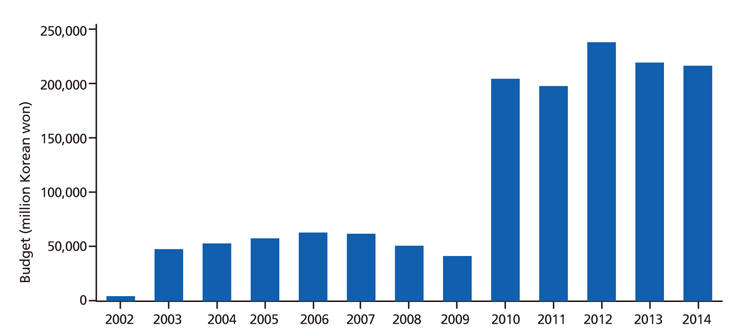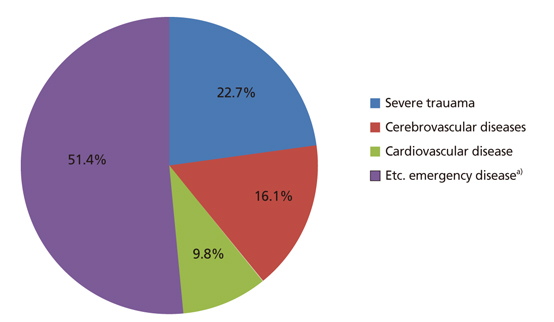Background and progress of regional trauma center development
- Affiliations
-
- 1National Emergency Medical Center, National Medical Center, Seoul, Korea. ermann@naver.com
- KMID: 2364055
- DOI: http://doi.org/10.5124/jkma.2016.59.12.919
Abstract
- In a modern medical delivery system, it is very difficult to provide adequate, timely, and equitable medical care for severely injured patients. Trauma is a leading cause of deaths under the age of 40 and a source of expensive socioeconomic losses in Korea. Korean government has been making a major effort to establish a trauma system since 2000, but inadequacies of the current trauma system still result in many preventable deaths from accidental injuries. The designation and support program for regional trauma centers is the first step in a national plan for trauma system development. At present, there are 9 regional trauma centers and 7 candidates for trauma centers. Regional trauma centers must play a key role in a regionally inclusive trauma system that integrates emergency medical services systems and healthcare delivery systems to deliver optimal medical care for injured patients.
MeSH Terms
Figure
Cited by 5 articles
-
Preventable Trauma Death Rate after Establishing a National Trauma System in Korea
Kyoungwon Jung, Ikhan Kim, Sue K. Park, Hyunmin Cho, Chan Yong Park, Jung-Ho Yun, Oh Hyun Kim, Ju Ok Park, Kee-Jae Lee, Ki Jeong Hong, Han Deok Yoon, Jong-Min Park, Sunworl Kim, Ho Kyung Sung, Jeoungbin Choi, Yoon Kim
J Korean Med Sci. 2019;34(8):. doi: 10.3346/jkms.2019.34.e65.Distribution of Trauma Deaths in a Province of Korea: Is “Trimodal” Distribution Relevant Today?
Kyungjin Hwang, Kyoungwon Jung, Junsik Kwon, Jonghwan Moon, Yunjung Heo, John Cook-Jong Lee, Yo Huh
Yonsei Med J. 2020;61(3):229-234. doi: 10.3349/ymj.2020.61.3.229.Plan for plastic surgeons to participate in trauma teams at regional trauma and emergency centers
Nam Kyu Lim, Dong Hee Kang
J Korean Med Assoc. 2018;61(12):710-714. doi: 10.5124/jkma.2018.61.12.710.An Evaluation of the Effect of Performance Improvement and Patient Safety Program Implemented in a New Regional Trauma Center of Korea
Yo Huh, Junsik Kwon, Jonghwan Moon, Byung Hee Kang, Sora Kim, Jayoung Yoo, Seoyoung Song, Kyoungwon Jung
J Korean Med Sci. 2021;36(22):e149. doi: 10.3346/jkms.2021.36.e149.Effects of Trauma Center Establishment on the Clinical Characteristics and Outcomes of Patients with Traumatic Brain Injury : A Retrospective Analysis from a Single Trauma Center in Korea
Jang Soo Kim, Sung Woo Jeong, Hyo Jin Ahn, Hyun Ju Hwang, Kyu-Hyouck Kyoung, Soon Chan Kwon, Min Soo Kim
J Korean Neurosurg Soc. 2019;62(2):232-242. doi: 10.3340/jkns.2018.0037.
Reference
-
1. Hyun KL, Lee SM, Choi KC, Lee SY, Kim JY. An analysis of socioeconomic costs of major diseases for prioritization on health security policy. Seoul: National Health Insurance Service;2012.2. Newgard CD, Meier EN, Bulger EM, Buick J, Sheehan K, Lin S, Minei JP, Barnes-Mackey RA, Brasel K. ROC Investigators. Revisiting the “golden hour”: an evaluation of out-of-hospital time in shock and traumatic brain injury. Ann Emerg Med. 2015; 66:30–41.
Article3. Kim Y, Jung KY, Cho KH, Kim H, Ahn HC, Oh SH, Lee JB, Yu SJ, Lee DI, Im TH, Kim SE, Park JH. Preventable trauma deaths rates and management errors in emergency medical system in Korea. J Korean Soc Emerg Med. 2006; 17:385–394.4. Maio RF, Burney RE, Gregor MA, Baranski MG. A study of preventable trauma mortality in rural Michigan. J Trauma. 1996; 41:83–90.
Article5. Esposito TJ, Sanddal ND, Dean JM, Hansen JD, Reynolds SA, Battan K. Analysis of preventable pediatric trauma deaths and inappropriate trauma care in Montana. J Trauma. 1999; 47:243–251.
Article6. Iau PT, Ong CL, Chan ST. Preventable trauma deaths in Singapore. Aust N Z J Surg. 1998; 68:820–825.
Article7. Esposito TJ, Sanddal TL, Reynolds SA, Sanddal ND. Effect of a voluntary trauma system on preventable death and inappropriate care in a rural state. J Trauma. 2003; 54:663–669.
Article8. Motomura T, Mashiko K, Matsumoto H, Motomura A, Iwase H, Oda S, Shimamura F, Shoko T, Kitamura N, Sakaida K, Fukumoto Y, Kasuya M, Koyama T, Yokota H. Preventable trauma deaths after traffic accidents in Chiba Prefecture, Japan, 2011: problems and solutions. J Nippon Med Sch. 2014; 81:320–327.
Article9. Ewha Womans University. Development of the guidelines for inter-hospital transfer. Seoul: Ministry of Health and Welfare;2007.10. Ministry of Health and Welfare. 2010-2011 Plans for trauma-specialized center evaluation and support. Seoul: Ministry of Health and Welfare;2010.11. Ewha Womans University. Korean trauma system evaluation and research for further development. Seoul: Ministry of Health and Welfare;2011.12. Moore L, Hanley JA, Turgeon AF, Lavoie A. Evaluation of the long-term trend in mortality from injury in a mature inclusive trauma system. World J Surg. 2010; 34:2069–2075.
Article13. Committee on Trauma American College of Surgeons. Resources for optimal care of the injured patient. Chicago: American College of Surgeons;2014.
- Full Text Links
- Actions
-
Cited
- CITED
-
- Close
- Share
- Similar articles
-
- Impact of trauma center care on mortality in Gangwon Province in Korea
- Understanding Regional Trauma Centers and managing a trauma care system in South Korea: a systematic review
- Changes in the clinical features and demographics of donors after brain death, before and after the establishment of a regional trauma center: 20 years of experience at a single center in Korea
- Trauma Volume and Performance of a regional Trauma Center in Korea: Initial 5-year analysis
- Proposal for stabilization of regional trauma centers in Korea



